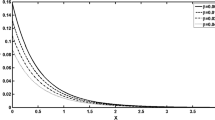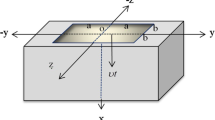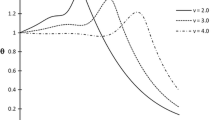Abstract
This paper presents a study on a two dimensional thermoelastic problem involving isotropic, homogeneous half-space media with a moving heat source. The problem has been constructed subject to exponentially varying temperature at the boundary. Laplace transformation and Fourier transformation are used to the governing equations and solutions are made for thermal stress distribution and temperature distribution in the Laplace–Fourier transformed domain. The inverse Laplace–Fourier transformation is obtained numerically and the results are presented graphically with discussions on different values of dam** parameter of exponentially varying temperature. It has been observed that an increment of the decaying parameter diminishes the magnitude of physical quantities. The significant effect of moving heat source velocity on stress and temperature has been noted.












Similar content being viewed by others
Abbreviations
- \(\lambda , \mu \) :
-
Lame’s constant
- \(\rho \) :
-
Density
- c :
-
Specific heat
- t :
-
Time
- \(\theta _0\) :
-
Reference temperature
- \(\sigma _{ij}\) :
-
Component of stress tensor
- \(e_{ij}\) :
-
Component of strain tensor
- \(u_i\) :
-
Component of displacement
- \(\theta \) :
-
Temperature increase with respect to the uniform reference temperature \(\theta _0\)
- \(\alpha _t\) :
-
Coefficient of linear thermal expansion
- \(K^*\) :
-
Material constant characteristic of the theory
- K :
-
Coefficient of thermal conductivity
- Q :
-
Rate of internal heat generation per unit mass
- l :
-
A standard length
- v :
-
A standard wave speed
- \(\varepsilon \) :
-
Thermoelastic coupling constant
- \(C_P\) :
-
Non dimensional dilatational
- \(C_S\) :
-
Shear wave velocity
- \(C_T\) :
-
Thermal wave velocity
- \(C_K\) :
-
Dam** co-efficient for Green–Nagdhi model III
References
Biot, M.A.: Thermoelasticity and irreversible thermodynamics. J. Appl. Phys. 27(3), 240–253 (1956)
Lord, H.W., Shulman, Y.: A generalized dynamical theory of thermoelasticity. J. Mech. Phys. Solids 15(5), 299–309 (1967)
Dhaliwal, R.S., Sherief, H.H.: Generalized thermoelasticity for anisotropic media. Q. Appl. Math. 38(1), 1–8 (1980)
Ignaczak, J.: Uniqueness in generalized thermoelasticity. J. Therm. Stresses 2(2), 171–175 (1979)
Ignaczak, J.: A note on uniqueness in thermoelasticity with one relaxation time. J. Therm. Stresses 5(3–4), 257–263 (1982)
Sherief, H.H.: On uniqueness and stability in generalized thermoelasticity. Q. Appl. Math. 44(4), 773–778 (1987)
Sherief, H.H., Dhaliwal, R.S.: A uniqueness theorem and a variational principle for generalized thermoelasticity. J. Therm. Stresses 3(2), 223–230 (1980)
Green, A., Lindsay, K.: Thermoelasticity. J. Elast. 2(1), 1–7 (1972)
Chandrasekharaiah, D.: Thermoelasticity with second sound: a review. Appl. Mech. Rev. 39(3), 355–376 (1986). https://doi.org/10.1115/1.3143705
Hetnarski, R.B., Ignaczak, J.: Generalized thermoelasticity. J. Therm. Stresses 22(4–5), 451–476 (1999)
Green, A., Naghdi, P.: A re-examination of the basic postulates of thermomechanics. Proc. R. Soc. Lond. A 432(1885), 171–194 (1991)
Green, A., Naghdi, P.: Thermoelasticity without energy dissipation. J. Elast. 31(3), 189–208 (1993)
Quintanilla, R., Racke, R.: Stability for thermoelasticity of type III. Discrete Contin Dyn Syst B 3, 383 (2003)
Quintanilla, R., Straughan, B.: A note on discontinuity waves in type III thermoelasticity. Proc. R. Soc. Lond. A Math. Phys. Eng. Sci. 460, 1169–1175 (2004)
Chandrasekharaiah, D.: A note on the uniqueness of solution in the linear theory of thermoelasticity without energy dissipation. J. Elast. 43(3), 279–283 (1996)
Chandrasekharaiah, D.S.: A uniqueness theorem in the theory of thermoelasticity without energy dissipation. J. Therm. Stresses 19(3), 267–272 (1996). https://doi.org/10.1080/01495739608946173
Chandrasekharaiah, D., Srinath, K.: Thermoelastic interactions without energy dissipation due to a point heat source. J. Elast. 50(2), 97–108 (1998)
Mallik, S.H., Kanoria, M.: A two dimensional problem for a transversely isotropic generalized thermoelastic thick plate with spatially varying heat source. Eur. J. Mech. A/Solids 27(4), 607–621 (2008). https://doi.org/10.1016/j.euromechsol.2007.09.002
Mallik, S., Kanoria, M.: Effect of rotation on thermoelastic interaction with and without energy dissipation in an unbounded medium due to heat source-an eigenvalue approach. Far East J. Appl. Math. 23, 147–167 (2006)
Abouelregal, A.E.: Generalized thermoelastic infinite transversely isotropic body with a cylindrical cavity due to moving heat source and harmonically varying heat. Meccanica 48(7), 1731–1745 (2013). https://doi.org/10.1007/s11012-013-9705-z
Roychoudhuri, S., Dutta, P.S.: Thermo-elastic interaction without energy dissipation in an infinite solid with distributed periodically varying heat sources. Int. J. Solids Struct. 42(14), 4192–4203 (2005). https://doi.org/10.1016/j.ijsolstr.2004.12.013
Banik, S., Mallik, S.H., Kanoria, M.: Thermoelastic interaction with energy dissipation in an infinite solid with distributed periodically varying heat sources. Int. J. Pure Appl. Math. 34(2), 229–243 (2007)
Amin, M.M., El-Bary, A.A., Youssef, H.M.: Two-dimensional problem of generalized thermoelastic half-space subjected to moving heat source. Microsyst. Technol. 23(10), 4611–4617 (2017). https://doi.org/10.1007/s00542-017-3281-4
Abouelregal, A.E., Yao, S.-W., Ahmad, H.: Analysis of a functionally graded thermopiezoelectric finite rod excited by a moving heat source. Results Phys. 19, 103389 (2020). https://doi.org/10.1016/j.rinp.2020.103389
Abouelregal, A.E., Ahmad, H., Yao, S.-W.: Functionally graded piezoelectric medium exposed to a movable heat flow based on a heat equation with a memory-dependent derivative. Materials 13(18), 3953 (2020). https://doi.org/10.3390/ma13183953
Abouelregal, A.E., Mohammad-Sedighi, H., Shirazi, A.H., Malikan, M., Eremeyev, V.A.: Computational analysis of an infinite magneto-thermoelastic solid periodically dispersed with varying heat flow based on non-local Moore-Gibson-Thompson approach. Continuum Mech. Thermodyn. (2021). https://doi.org/10.1007/s00161-021-00998-1
Chandrasekharaiah, D.: Hyperbolic thermoelasticity: a review of recent literature. Appl. Mech. Rev. 51(12), 705–729 (1998)
Piskunov, V.N., Sokovishin, Yu.A., Stepanov, V.F.: Free convection around a plate with temperature decreasing exponentially along the surface. J. Eng. Phys. 19(2), 933–935 (1970). https://doi.org/10.1007/BF00828762
Abouelregal, A.: Rotating magneto-thermoelastic rod with finite length due to moving heat sources via Eringen’s nonlocal model. J. Comput. Appl. Mech. 50(1), 118–126 (2019). https://doi.org/10.22059/jcamech.2019.275893.360
Honig, G., Hirdes, U.: A method for the numerical inversion of Laplace transforms. J. Comput. Appl. Math. 10(1), 113–132 (1984)
Youssef, H.M., Al-Lehaibi, E.A.: State-space approach of two-temperature generalized thermoelasticity of one-dimensional problem. Int. J. Solids Struct. 44(5), 1550–1562 (2007)
Author information
Authors and Affiliations
Ethics declarations
Conflict of interest
On behalf of all authors, the corresponding author states that there is no conflict of interest.
Additional information
Publisher's Note
Springer Nature remains neutral with regard to jurisdictional claims in published maps and institutional affiliations.
Appendix 1
Appendix 1
Inversion of the Fourier transform If \(\bar{f}^{*}(x,q,p)\) Laplace–Fourier transform of the function f(x, y, t) then the inversion for Fourier transform carried out in following manners
where \(\bar{f_1}^*\) and \(\bar{f_2}^*\) represent the even and odd parts of \(\bar{f}^*\). Henceforth, first the transformation \(z=e^{-q}\) and then the Gauss-quadrature formula for 7-point has been applied to obtain \(\bar{f}(x,y,p)\).
Inversion of the Laplace transform According to Honig and Hirdes [30] The inversion formula of \(\bar{f}(x,y,p)\) is
where \(d>\) all real parts of the singularities (for p) of \(\bar{f}(x,y,p)\). Expand the function \(g(x,y,d,t)=e^{-dt}f(x,y,t)\) in a Fourier series in the interval [0, 2T] for time variable. Thus the approximate formula is
here \(c_k=\frac{e^{dt}}{T}Re[e^{ik\pi / T} \bar{f}(x,y,d+ik\pi /T)]\).
Two methods such as Korrecktur and \(\varepsilon \)-algorithm are used to reduce the discretization error and the truncation error and after that to accelerate the convergence. The Korrektur method is used to evaluate the function f(x, y, t) and is defined as:
whereas, the \(\varepsilon \)-algorithm is employed to increase the rate of convergence of the series given in approximation formula (49). Let N = 2r + 1 is an odd natural number and \(s_m=\sum _{k=1}^{m}c_k\) in (49). The \(\varepsilon \)-algorithm is:
then the sequence \( {\varepsilon _{1}}^{(1)},{\varepsilon _{3}}^{(1)},{\varepsilon _{5}}^{(1)} \dots \) converges to \(f_{\infty }(x,y,t)-c_0/2\).
Rights and permissions
About this article
Cite this article
Mandal, S., Pal Sarkar, S. Solution of a Two Dimensional Thermoelastic Problem Due to an Exponentially Distributed Temperature at the Boundary in Presence of a Moving Heat Source. Int. J. Appl. Comput. Math 8, 77 (2022). https://doi.org/10.1007/s40819-021-01166-4
Accepted:
Published:
DOI: https://doi.org/10.1007/s40819-021-01166-4
Keywords
- Thermoelasticity
- Isotropic homogeneous media
- Exponentially distributed temperature
- Moving heat source
- Laplace transformation
- Fourier transformation




